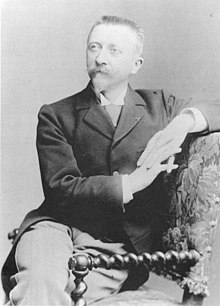Édouard Niermans (architect)
| Édouard-Jean Niermans | |
|---|---|

Édouard-Jean Niermans in 1895 by Pierre Petit
|
|
| Born |
Eduard Johan Niermans 30 May 1859 Enschede, Netherlands |
| Died | 19 October 1928 (aged 69) Montlaur, Aude |
| Nationality | Dutch, French |
| Known for |
Moulin Rouge Théâtre des Capucines Hôtel Negresco |
Édouard-Jean Niermans (born Eduard Johan Niermans) (30 May 1859 – 19 October 1928) was a famous Dutch-born French architect during the Belle Époque.
Eduard Johan Niermans was born on 30 May 1859 in Enschede, son of the architect Gerrit Doorwaard Niermans (1807-1871) and his fourth wife, Johanna Margaretha Sangster (1817-1869). He was the youngest of their four children. He studied at the Polytechnic School in Delft, earning his diploma in 1883. Having a taste for French culture, he moved to 41 quai d'Anjou in Paris, where he tried to gain recognition at first as a designer of furniture and interior decorations. As a member of the Dutch community in Paris he was chosen to build the Dutch pavilion at the Exposition Universelle (1889) in collaboration with . He was awarded the Legion of Honor for this notable work.
Niermans definitely returned to architecture in 1891, and by 1894 his personal style had emerged from the Dutch influence. It was based on an extensive knowledge of styles of the past and the expectations of the public. Modern materials allow him to combine taste for the past with modern comfort for customers. He was naturalized as a French citizen in 1895 and joined the Central Society of Architecture, sponsored by the famous architect Charles Garnier.
In Paris he was involved in the decor and construction or renovation of many brasseries and theaters including the brasserie Mollard (1894–95), the Casino de Paris (1892-96), the Trianon-concert (1894–95), the tavern Pousset (1897–98), the Folies Bergère (1900) and the Moulin Rouge (1903). He designed the Royal Palace Hotel in Ostend in 1900, with a huge and ornate entrance, and with much of the wall of the central block of the hotel made of glass. The hotel has since been demolished. He also rebuilt the Hôtel du Palais in Biarritz, which had been badly damaged by a fire in 1903. Niermans extended the south wing, added two stories, and added a large bay holding a magnificent restaurant. The hotel now had larger salons for entertainments, and a salle des fêtes in Second Empire style. This project was completed in 1905.
...
Wikipedia
